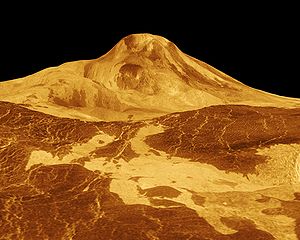Our website is made possible by displaying online advertisements to our visitors.
Please consider supporting us by disabling your ad blocker.
Volcanism on Venus

The surface of Venus is dominated by volcanic features and has more volcanoes than any other planet in the Solar System. It has a surface that is 90% basalt, and about 65% of the planet consists of a mosaic of volcanic lava plains, indicating that volcanism played a major role in shaping its surface. There are more than 1,000 volcanic structures and possible periodic resurfacing of Venus by floods of lava. The planet may have had a major global resurfacing event about 500 million years ago,[1] from what scientists can tell from the density of impact craters on the surface. Venus has an atmosphere rich in carbon dioxide, with a pressure that is 90 times that of Earth's atmosphere.
There are over 80,000[2] volcanoes on Venus detected through radar mapping. For many years scientists debated on whether Venus was currently active or if the volcanic structures were remnants from the past. There are few impact craters on Venus' surface which pointed to relatively recent resurfacing.[3] The most likely resurfacing event would have been volcanic flows. Radar sounding by the Magellan probe revealed evidence for comparatively recent volcanic activity at Venus's highest volcano Maat Mons, in the form of ash flows near the summit and on the northern flank. Although many lines of evidence such as this suggest that volcanoes on Venus have been recently active, present-day eruptions at Maat Mons have not been confirmed. Nevertheless, other more recent studies, in 2020, suggest that Venus, though not Maat Mons specifically, is indeed currently volcanically active.[4][5] In 2023, scientists reexamined topographical images of the Maat Mons region taken by the Magellan orbiter. Using computer simulations they determined that the topography had changed during an 8-month interval, and have concluded that active volcanism was the cause.[6] Until 2023, there had only been hints of active volcanism. In March 2023, Herrick et al. announced that they had imaged a vent expanding in Magellan images, indicating active volcanism on Venus.[7]
- ^ D.L. Bindschadler (1995). "Magellan: A new view of Venus' geology and geophysics". American Geophysical Union. Retrieved 2007-09-13.
- ^ Hahn, Rebecca M.; Byrne, Paul K. (April 2023). "A Morphological and Spatial Analysis of Volcanoes on Venus". Journal of Geophysical Research: Planets. 128 (4). Bibcode:2023JGRE..12807753H. doi:10.1029/2023je007753. ISSN 2169-9097. S2CID 257745255.
- ^ Schaber, G. G.; Strom, R. G.; Moore, H. J.; Soderblom, L. A.; Kirk, R. L.; Chadwick, D. J.; Dawson, D. D.; Gaddis, L. R.; Boyce, J. M.; Russell, Joel (1992). "Geology and distribution of impact craters on Venus: What are they telling us?". Journal of Geophysical Research. 97 (E8): 13257. Bibcode:1992JGR....9713257S. doi:10.1029/92je01246. ISSN 0148-0227.
- ^ Hall, Shannon (9 January 2020). "Volcanoes on Venus Might Still Be Smoking - Planetary science experiments on Earth suggest that the sun's second planet might have ongoing volcanic activity". The New York Times. Retrieved 10 January 2020.
- ^ Filiberto, Justin (3 January 2020). "Present-day volcanism on Venus as evidenced from weathering rates of olivine". Science. 6 (1): eaax7445. Bibcode:2020SciA....6.7445F. doi:10.1126/sciadv.aax7445. PMC 6941908. PMID 31922004.
- ^ Kluger, Jeffrey (17 March 2023). "Why the Discovery of an Active Volcano on Venus Matters". Time. Retrieved 19 March 2023.
- ^ Herrick, Robert R.; Hensley, Scott (2023-03-24). "Surface changes observed on a Venusian volcano during the Magellan mission". Science. 379 (6638): 1205–1208. Bibcode:2023Sci...379.1205H. doi:10.1126/science.abm7735. ISSN 0036-8075. PMID 36921020. S2CID 257571905.
Previous Page Next Page


